

Twitter Moments - A New Way to Follow Trending Events. Educational Hash Tags. #edude#eduFollowChallenge#edugreen #eduhashtag #eduit#edumindset#eduON (Ontario)#euduoz #edupd#edupreneur#edupunk #edutech #EduThingsILike#eduvc#eduvoxers #elemchat #elementary#elemsci #ell #ellchat#elrnchat #elt#eltchat#eltpics#emchat #emotionalliteracy#edpolitics #engagechat#engchat #engedu #EngineeringEducation#english #english-teacher#engsschat #enrichingkids#enviroed#e-safety#ESCchat#esdgc#esea#esl #esol#esp#ETAS#etcchat#ETcoaches#etmchat#ettipad #e20#expandedlearning #family#fb4ed#FCE#FETC #FF#fft#filmclass#finnedchat#fitnessedu#flatclass #flatclassroom#FLE#flipblogs#flipchat #flipclass#flipped#flippedclassroomflippedlearning#flteach#FOAMed #followalibrarian #followfriday#fooded#foodtechteachers #formativeassessment#forteachers #frenchchat#frimm#fstenet#FutureReady#FYCchat.

Now on Twitter: group Direct Messages and mobile video camera. A few months ago, we mentioned some features coming soon, and today we’re excited to start rolling out two of them: group messaging and a new mobile video experience.
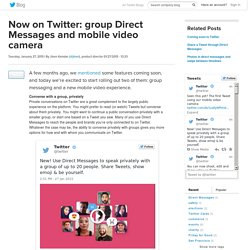
Converse with a group, privatelyPrivate conversations on Twitter are a great complement to the largely public experience on the platform. You might prefer to read (or watch) Tweets but converse about them privately. You might want to continue a public conversation privately with a smaller group, or start one based on a Tweet you saw. Many of you use Direct Messages to reach the people and brands you’re only connected to on Twitter. Practical Advice for Teaching with Twitter. Last week I introduced a pedagogical framework for using Twitter in your teaching, organized along two axes: monologic to dialogic and passive to active.
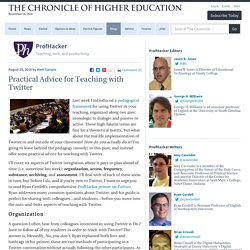
These high-falutin terms are fine for a theoretical matrix, but what about the real life implementation of Twitter in and outside of your classroom? How do you actually do it? I’m going to leave behind the pedagogy (mostly) in this post, and instead offer some practical advice for teaching with Twitter. I’ll cover six aspects of Twitter integration where it pays to plan ahead of time (i.e. sometime last week): organization, access, frequency, substance, archiving, and assessment. I’ll deal with of each of these areas in turn, but before I do, and if you’re new to Twitter, I want to urge you to read Ryan Cordell’s comprehensive ProfHacker primer on Twitter.
How to Start Tweeting (and Why You Might Want To) We’ve written a lot about Twitter here at ProfHacker.
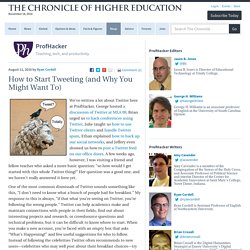
George hosted a discussion of Twitter at MLA 09, Brian urged us to hack conferences using Twitter, Julie taught us how to use Twitter clients and handle Twitter spam, Ethan explained how to back up our social networks, and Jeffery even showed us how to post a Twitter feed on our office doors. A few weeks ago, however, I was visiting a friend and fellow teacher who asked a more basic question: “so how would I get started with this whole Twitter thing?” Her question was a good one, and we haven’t really answered it here yet. One of the most common dismissals of Twitter sounds something like this, “I don’t need to know what a bunch of people had for breakfast.” My response to this is always, “if that what you’re seeing on Twitter, you’re following the wrong people.” OPINION: Twitter Supports These Changing Times in Education. EdSurge Newsletters Receive weekly emails on edtech products, companies, and events that matter.

As I write this article, education is making a shift towards increased rigor and accountability for teachers, students, and administrators. With the new Common Core State Standards and the Smarter Balanced assessments out and about, students and teachers are being pushed to new levels. Education is no longer defined in terms of what a teacher will teach, but rather in terms of what a student will be able to demonstrate. But that’s not the only big shift. Over 100 ideas for using Twitter in the Classroom. This handful of resources provide about 100 different ideas for, and examples of, using Twitter in the classroom.

It’s been almost 8 months since I published the post, “6 Examples of Using Twitter in the Classroom”, about uses of the popular micro-blogging tool in the instructional setting. This post generated a lot of traffic, and continues to attract hundreds of viewers every week. Since that brief posting, I’ve come across a lot of articles containing examples and suggestions for using Twitter in instructional applications. I’ve combed through many of these and tried to boil down the redundancies to create a rich set of idea-laden resources. The Complete Guide To Twitter Hashtags For Education. What is a hashtag?

A word or phrase preceded by a “#.” How do hashtags work? Twitter can be a busy place with lots of tweets–and thus lots of “noise.” A #hashtag is a way to aggregate tweets that are appended with a hashtag. Picture it like a magnet that attracts all messages categorized by that topical word or phrase. A Teacher’s 3 Twitter Accounts. Twitter is the simplest system available to interact with the web and share resources.
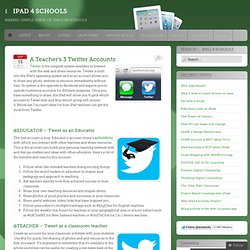
Twitter is built into the iPad’s operating system and so an account allows you to share any photo, website or resource immediately without fuss. Its system is the opposite to Facebook and expects you to operate numerous accounts for different purposes. Once you have something to share, the iPad will allow you to pick which account to Tweet with and thus which group will receive it. Below are 3 account ideas for how iPad teachers can get the most from Twitter. @EDUCATOR – Tweet as an Educator. Using Twitter in the classroom - my firsthand experience. Resource: An A-Z of Twitter for Educators. The Compelled Educator: Don't Use Twitter with Your Students.
Maybe you’d like to say to me, “Jennifer, how can you say not to use twitter with our students?
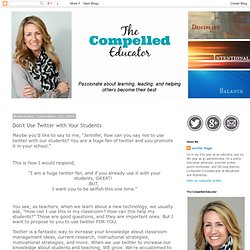
You are a huge fan of twitter and you promote it in your school.” This is how I would respond, The Compelled Educator: Teachers Harness the Simple Power of Twitter. I had to share this great story of how one of our teachers took the initiative to bring down the four walls of the classroom and connect her students to others via social media.

Last week, while visiting classrooms and tweeting the wonderful experiences our students were having, I tweeted this: Students in Ms. Gannon's English 11 class were watching a TEDx Talk by Paul Piff titled, "Does Money Make You Mean? " The Beginner’s Guide To Twitter – Downloadable Course - GEDB. Teacher's Visual Guide to Creating Twitter Lists. June 10, 2014 A Twitter list is a curated group of Twitter users and a great way to organize your interests.
You can use them to categorize and organize tweets into different categories relevant to the information you are seeking. You can for instance create a list about educational technology and add to it Edtech tweeters you follow. In this way , you will have a pool of resources aggregated in a single page to access anytime you want. You can create your own lists or subscribe to lists created by others. Viewing a list timeline will show you a stream of Tweets from only the users on that list. Here is how to create your own Twitter list: 1- Head over to your Twitter homepage and click on the "gear" button on the top right and select "lists" 2- Click on " Create new list" 3- Type in a name and description to your list. New Wonderful Twitter Guide for Teachers and Educators. June 18, 2014 As I have repeatedly stated in several instances here in Educational Technology and Mobile Learning, online social networking remains one of the powerful routes to any effective and sustained teacher professional development plans.
Social networks open up a whole new horizon of promising opportunities for on-the-go and at-any-time learning. One of the preeminent social networking site in this regard is the microblogging platform Twitter. Via-twitter 2. The Ultimate Twitter Guidebook For Teachers. Adopting a new communication tool is not easy. Figuring out the best way YOU can use Twitter is even harder. Luckily you are not going it alone. We have culled the following resources from an array of websites that try to help anyone understand and better use Twitter. The microblogging service is growing in leaps and bounds (and having plenty of server downtime because of it and the World Cup) as it seems everyone is joining and sharing their lives with the service.
If you haven’t yet taken the plunge, perhaps the following 100 resources might help you out. Busy teachers may feel that taking the time to learn how to use Twitter isn’t worth the return for the students benefit, so that’s why this list of 100 tips, apps, and resources is worth browsing. TeachPaperless: ISTE 2010: You Have Seen the Future.
Twitter Tools. Educational Leadership:Schools, Families, Communities:Twitter: Not Just About Ham Sandwiches. For people who don't use it, Twitter seems like an incredible waste of time. "I surely don't need to know that someone had a ham sandwich for lunch! " is a common complaint. We agree—even the best ham sandwich isn't likely to be worth a virtual conversation. But 140 characters (the maximum length of a Twitter message, or "tweet") can be enough to share quick updates and links to important information. Take a look at how a Nixa, Missouri, school district employed Twitter during a series of serious thunderstorms and a tornado watch: 6:22 a.m., May 8: We've cleared out all our "trailers" due to the bad weather. 7:03 a.m., May 8: No damage at any of our schools as of right now. 7:28 a.m., May 8: We do have some minor damage around the district. 7:47 a.m., May 8: We have a light pole down across the JH track. 7:53 a.m., May 8: We are now releasing the elementary students to complete their bus routes from the morning. 8:22 a.m., May 8: Power back on at Inman Elementary.
Whoa! Getting Started. Educational Leadership:Meeting Students Where They Are:Why Teachers Should Try Twitter. How to get better at Twitter. Twitter can be an incredibly robust community of movers, shakers, interesting story sharers, collaborators, clients, customers, mentors, potential business partners, and friends. It can also be an overwhelming stream of more information than you can possibly read and a sea of eyes that pass right over whatever you’re saying.
Having a huge community of folks right in front of you and an invisible wall between you and them can be a really frustrating experience. After all, for a long time, Twitter’s tagline on their homepage (for non-registered users) was “join the conversation”. And we all know that conversations are much better when they aren’t with just yourself. But fear not – there are many different ways you can go about harnessing the awesomeness that can come about from using Twitter strategically. Maintain Visibility Tweet often and tweet in the afternoon. 4:00pm is the most RT’d time of the day, and the highest volume happens between 3 and 7pm. Rally Support Share Unique Content.
Twitter Education Strategies. TeachPaperless: ISTE 2010: You Have Seen the Future. 5 Great Ways Students can use Twitter for Research. 1. Create a poll A great starting point for research is the generation of new statistical results on a given topic, but when restricted to their own friends and contacts, it can be difficult for students to get enough results to provide a representative sample. This problem can be solved via Twitter using a clever tool like Pollowers or Poll Everywhere, which literally turns your Twitter followers’ tweets into poll responses. Simply ask a question in a tweet, then sit back and watch as the tool catalogues responses, allowing you to follow and record the results in real-time. 2. 50 Ways to Use Twitter in the Classroom. Twitter for Teachers. Twitter Session. Twitter in 60 seconds.
A printable 1-page Twitter guide for all skill levels. Guide to Using Twitter in Your Teaching Practice : KQED Education. Twitterforeducation - Educational Uses of Twitter. Twitter me this…why use Twitter for school communication? Twitter: Best Practices For Educators #ReinventingWriting. Twitter is a Teacher Superpower! Practical Advice for Teaching with Twitter – ProfHacker. Twitter Educator Connections.